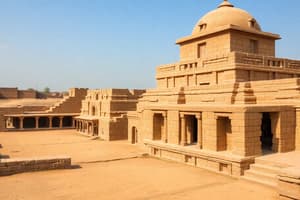Podcast
Questions and Answers
What was Franklin D. Roosevelt's concern for the survival of civilization?
What was Franklin D. Roosevelt's concern for the survival of civilization?
- The cultivation of the science of human relationships (correct)
- The creation of new economic systems
- The development of scientific technology
- The exploration of new geographical territories
Where did the Indus Civilization extend along the Indus River?
Where did the Indus Civilization extend along the Indus River?
- From southwest Afghanistan to northeast Pakistan
- From south Pakistan to north India
- From northeast Afghanistan to northwest India (correct)
- From northwest Afghanistan to southeast India
What was the significance of Harappa and Mohenjo-Daro?
What was the significance of Harappa and Mohenjo-Daro?
- They were the centers of trade and commerce in ancient India
- They were the capitals of ancient Egypt and Mesopotamia
- They were the two great cities of the Indus Valley Civilization (correct)
- They were the oldest cities of the Indus Valley Civilization
Who was noted for his discoveries in Great Britain and India and for his advancement of scientific method in archaeology?
Who was noted for his discoveries in Great Britain and India and for his advancement of scientific method in archaeology?
What was the result of Sir Mortimer Wheeler's research in India?
What was the result of Sir Mortimer Wheeler's research in India?
What was the primary basis for creating a chronology of the Harappan civilization?
What was the primary basis for creating a chronology of the Harappan civilization?
During which phase of the Harappan civilization was lapis lazuli initially exported?
During which phase of the Harappan civilization was lapis lazuli initially exported?
What was a characteristic of the Early Harappan phase?
What was a characteristic of the Early Harappan phase?
What is believed to have contributed to the decline of the Harappan civilization?
What is believed to have contributed to the decline of the Harappan civilization?
What happened to the cities during the Post-Harappan phase?
What happened to the cities during the Post-Harappan phase?
Flashcards are hidden until you start studying
Study Notes
Human Relationships and Civilization
- Franklin D. Roosevelt emphasizes the importance of cultivating the science of human relationships to ensure the survival of civilization.
Indus Valley Civilization
- The Indus Valley Civilization, also known as the Harappan Civilization, is the earliest known urban culture of the Indian subcontinent.
- The civilization flourished from 2500-1700 BCE, with the southern sites possibly lasting later into the 2nd millennium BCE.
- It is one of the three earliest civilizations, along with Mesopotamia and Egypt, and is the most extensive of the three.
Chronology
- The Indus Valley Civilization existed from 3300-1300 BCE, with its early years (3300-1300 BCE) and mature period (2600-1900 BCE).
- The civilization's area extended along the Indus River from northeast Afghanistan, into Pakistan, and northwest India.
- Harappa and Mohenjo-Daro were the two great cities of the Indus Valley Civilization, emerging around 2600 BCE.
Phases of the Harappan Civilization
- Pre-Harappan (c. 7000-5500 BCE): The Neolithic period, characterized by agricultural development, domestication of plants and animals, and production of tools and ceramics.
- Early Harappan (c. 5500-2800 BCE): Trade was established with Egypt, Mesopotamia, and possibly China, with the construction of ports, docks, and warehouses.
- Mature Harappan (c. 2800-1900 BCE): The construction of great cities, widespread urbanization, and the flourishing of cities like Harappa and Mohenjo-Daro.
- Late Harappan (c. 1900-1500 BCE): The decline of the civilization, coinciding with the migration of the Aryan people from the north, and climate change causing flooding, drought, and famine.
- Post-Harappan (c. 1500-600 BCE): The cities were abandoned, and the people had moved south.
Notable Archaeologists
- Sir Mortimer Wheeler, a British archaeologist, made significant discoveries in Great Britain and India and advanced the scientific method in archaeology.
- Wheeler's work provided a means to recognize approximate dates from the civilization's foundations through its decline and fall.
Studying That Suits You
Use AI to generate personalized quizzes and flashcards to suit your learning preferences.




